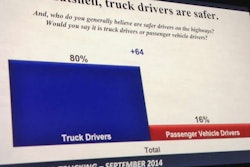 You can view video from the CNBC series via this link. Those wishing to file comments with the network directly can use the page at this link.
You can view video from the CNBC series via this link. Those wishing to file comments with the network directly can use the page at this link.Reactions were swift in coming to the announcement of the Wednesday airing of a four-part special on the CNBC cable business-news network titled “Collision course,” which in part wonders at the lack of regulation of the “unsafe” trucking industry. As in other such mainstream industry coverage of late, statistics are presented in a manner that suggests every crash a truck is involved in is the fault of the truck driver.
And worse, as Owner-Operator Independent Drivers Association spokesperson Norita Taylor pointed out in an association press release July 31, this and many other editorials and mainstream spotlights on the industry may even undermine “efforts to bring meaningful improvements to highway safety.”
“Our members believe the stories do more harm than good to public safety, and (they) want the motoring public to know that truck drivers log millions more accident-free miles than otherwise,” Taylor said.
Likewise, as former American Trucker host Robb Mariani noted:
@channel19todd So misleading CNBC! Stats prove trillions of miles traveled- pro truckers were involved in less than 2% of ALL incidents!
— Robb Mariani – Host (@robbmariani) July 30, 2014
And in only around a fifth or a fourth of truck-involved accidents does the truck driver shares in fault, as has been established by a variety of studies.
Mariani was echoed by owner-operator Pete Zimmer in the letter he wrote to Overdrive the same day, as the CNBC series went live. “Put the safety where needed,” Zimmer said, urging further education of auto drivers. “Increase fines to make an impact. Put regulations where the biggest problems lie. Make fines equal for all. We are all on the same highways.”

OOIDA’s Taylor agrees on the need for further education: “One primary area of safety efforts should be educating the motoring public about driving around trucks. There should be standardized training for new truck drivers as well.”
Part of the Association’s Truckers for Safety.com effort is aimed at getting the Federal Motor Carrier Safety Administration to finally develop Entry Level Driver Training standards for nationwide implementation, required by legislation but long put on the agency back burner. Otherwise, the Truckers for Safety campaign “looks at ways to improve highway safety without imposing burdensome regulations in a variety of areas,” OOIDA’s press release notes, a mission many readers would view as sensible, and directly counter to the fix described by sundry mainstream reports of late, further restrictions on hours and/or technological patches that plenty of safe truckers see as just another expense.
In many cases, as AsktheTrucker.com’s Allen Smith noted in the Overdrive’s Trucking Pro LinkedIn group, more regulations just create more problems with fatigue. His response to CNBC press emails on the series included this: “Shows omitting the causes [of driver fatigue] will not resolve the true problems of truck safety in this county. There are many issues going on within the trucking industry which relate to this. Increased regulations are causing more problems and fatigue.”
The CNBC series itself wondered why there is not a “national outcry” for more regulations — though it may be wishful thinking, perhaps the public these reports are aimed at is more attuned to reality than the reports’ authors believe. As Dianne Vranesic put it quite simply, commenting on the CNBC report on Overdrive‘s Facebook page, “‘Under-regulated’? Are you kidding?”
Says OOIDA’s Taylor, “At a time when annual turnover is more than 100 percent, the effort should be to find ways to keep drivers in the industry and have new drivers view it as a career choice. It’s safer for everyone when drivers stay in the business rather than leaving and creating a void filled by new, inexperienced drivers.”
More reader reaction to the CNBC series:
Via Twitter
Richard Wilson @regguy69: Again, all negativity by a biased mainstream media! Nothing truly discussed on improving crash causation!
Via Facebook
Lynn Pettus-Baker: Funny how they investigate us, but they never investigate the way four-wheelers drive on the road around us. Cutting us off, slamming on brakes in front of us, distracted while driving around us, etc. The list goes on and on…
Warren Wylds: Will they address the lack of flexibility, [which], not fatigue, is the cause of most collisions?
Bart Stevenson: Well, I don’t have to watch. Just by the [“Collision course”] title I know how this is probably going to end.














